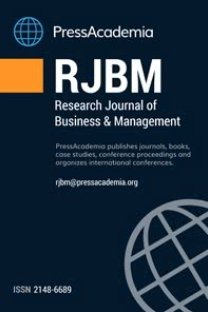THE EFFECT OF MARKET ORIENTATION AND INNOVATION ON COMPETITIVE ADVANTAGES
Purpose- Identify competitive advantages of embroidery SMEs embroidery from the aspect of market orientation and SME innovation. SME market orientation is applied from the ability of SMEs in finding market information to develop strategies and policies while SME Innovation from SMEs ability to apply technical innovation, product / service innovation and process innovation. Methodology- Population of this research is the entrepreneurs and managers of SMEs embroidery in Pakis subdistrict Malang and Bangil subdistrict Pasuruan with a sample of 90 respondents. Analysis of the data in this study is done by using multiple regressions. Findings- The results showed that the market orientation and innovation have a significant effect on competitive advantage. In order to gain a competitive advantage, then entrepreneurs and managers of small and medium enterprises (SMEs) embroidery in District Pakis Malang and Bangil Pasuruan develop marketing strategies by taking into account market orientation with the emphasis on the ability to monitor competitors and develop or doing innovations related to new products.Conclusion, Market orientation affects the competitive advantage which is an indicator of competitor orientation and Innovation affects on the competitive advantage which is an indicator of technical innovation that are considered to have the largest or most powerful contribution as a reflection of the innovation variable.
___
- Amit, R. and P.J.H. Schoemaker. 1993. Strategic Assets and Organizational Rent, Strategic Management Journal, Vol.14, pp.33-46.
- Arikunto, S. 2006. Prosedur Penelitian Suatu Pendekatan Praktek. Jakarta, PT. Rineka Cipta.
- Barnes, James G. 2003. Secret Of Customer Relationship Manangement. Alih bahasa. Andreas Winardi. Yogyakarta : Penerbit Andi.
- Barney, Jay.1991. Firm Resources and Sustained Competitive Advantage. Journal of Management, Vol. 17, No. l,pp.99-120
- Chuang, S.H. 2004. A Resource-based view on Knowledge manufacturing Capability dan Competitive advantage: An Empirical Investigation. Expert Systems with Applications, 27, pp. 459-465.
- Cleveland, J. and P. Plastrik, 1995. Learning, Learning Organization and TQM. In A.M. Hoffman and D.J. Julius (Eds), Total Quality Management: Implications for Higher Education, Maryville, MO: Prescott, pp. 233- 243.
- Cunningham, J.B. and P. Gerrard, 2000. Characteristics of Well-Performing Organisations in Singapore, Singapore Management Review, Vol. 22, No.1, pp.35-64.
- Damanpour F. 1991. Organizational innovation: a meta-analysis of effects of determinants and moderators. The Academy of Management Journal, Vol. 34, No. 3, pp. 555-590.
- Dewi, Sensi Buana.2006. Analisis pengaruh orientasi pasar Dan inovasi produk Terhadap keunggulan bersaing Untuk meningkatkan kinerja pemasaran (Studi pada Industri Batik di Kota dan Kabupaten Pekalongan). Tesis, Program Studi Magister Manajemen Universitas Diponegoro
- De Jong, J & Hartog, D D.2003. Leadership as a determinant of innovative behaviour. Scientific AnaLysis of Entrepreneurship and SMEs. Pp. 1-77.
- Farrell Mark Anthony,.2008. Market orientation, learning orientation and organisational performance in international joint ventures. Journal of Marketing and Logistics. Vol. 20 No. 3,2008. pp. 289-308
- Ferdinand, Augusty.,2000. Manajemen Pemasaran:Sebuah pendekatan Strategy. Research Paper Series. No.01 Program Magister Manajemen Universitas Diponegoro
- Ferdinand,Augusty.2006. Metode Penelitian Manajemen, pedoman penelitian untuk penulisan skripsi, tesis dan disertasi ilmu manajemen, Badan Penerbit Universitas Diponegoro
- Grant, R.M.2002. Contemporary Strategic Analysis, 4th Ed., Oxford: Blackwell
- Gujarati, D.2000. Essentials of Econometrics, International Editon, McGraw-Hill.
- Hollensen Svend.2010. Marketing Management: A Relationship Approach, second edition, Pearson Education Limited.
- Malhotra, N.K.2006. Marketing Research, London. Prentice Hall International Industri.
- Monge, PR.,M.D.Cozzens & NS.Contractor.1992. Communication and Motivational Predictors of the Dynamics of Organizational Innovation, Organization Science, 1, 135-148.
- Njuguna, I. Jhon.2009. Strategic Positioning For Sustainable Competitive Advantage: An Organizational Learning Approach. Journal of Business Management: Vol. 2, Issue 1. pp. 32-43.
- Penrose, E.T.1999. The Theory of the Growth of the Firm, 7rd Edition, New York: Oxford University Press.
- Peteraf, M.A.1993. The Cornerstones of Competitive Advantage: a Resource-Based View, Strategic Management Journal, Vol.14, No. 3, pp.179-191.
- Pitelis, Christos.2009. Edith Penrose's `The Theory of the Growth of the Firm' Fifty Years Later. MPRA Munich Personal RePEc Archive, Paper No. 23180.
- Porter, M.E.2004. The Competitive Advantages of Nations, Harvard Business Review.
- Porter, Michael, E.1993. Competitive Strategy. The Free Press. New York.
- Ratnawati.2017. SME’S Innovation of The Mediator of The Influence of The Implementation of CSR Program on Competitive Advantage of SME’s in Malang. Journal Of Applied Management.Vol.15,Issue 2,pp.261-270.
- Robbins, S.P.2006. Perilaku Organisasi. Edisi Kesepuluh. Jakarta. Penerbit Erlangga.
- Rogers, M, E. 1983. Diffusion of Inovations, The Free Press, NewYork.
- Senge, P.M.1990. The Leader’s New Work: Building Learning Organizations, Sloan Management Review, Fall 32 (1), pp.7-23.
- Singarimbun, Masri.1999. Metode Penelitian Survai. Jakarta: LP3ES
- Singarimbun, M dan Sofian E.2005. Metode Penelitian Survei. LP3ES, Jakarta.
- Sugiono. 2006. Metode Penelitian Administrasi. Alfabeta, Bandung:
- Suliyanto. 2011. The Effect Of Orientation Learning On Competitive Advantage Through Innovation: Study On Small And Medium Enterprises. Business and Management Review, Vol. 1 (7) pp. 28 – 36
- Supranoto, Meike. 2009. Strategi menciptakan keunggulan Bersaing produk melalui orientasi pasar ,Inovasi, dan orientasi kewirausahaan Dalam rangka meningkatkan kinerja Pemasaran (Studi empiris pada: Industri Pakaian Jadi Skala Kecil dan Menengah di kota Semarang). Tesis, Program Studi Magister Manajemen Universitas Diponegoro
- Uncles, Mark. 2000. Market Orientation. Australian Journal of Management. Vol.25, No.2.pp. 1-15
- Wang, Y. and H. Lo. 2003. Customer-focused Performance and the Dynamic Model for Competences Building and Leveraging: A Resourcebased View, Journal of Management Development, Vol.22, No.6, pp.483-526.
- Wanto dan Ruswiati.2012. The Effect Of Organizational Culture And Organizational Learning Towards The Competitive Strategy And Company Performance (Case Study Of East Java Smes In Indonesia: Food And Beverage Industry). Information Management and Business Review, Vol. 4, No. 9, pp. 467-476
- Wheelen, T.L. and J. David Hunger,2002. Strategic Management and Business Policy. Eighth Edition, New Jersey: Prentice-Hall.
- Zhou. Kevin Zheng, James R. Brown,and Chekitan S. Dev.2009. Market orientation, competitive advantage, and performance: A demandbased perspective. Journal of Business Research, Vol. 62, Issue 11, pp. 1063–1070
- Yayın Aralığı: Yılda 4 Sayı
- Başlangıç: 2014
- Yayıncı: PressAcademia
